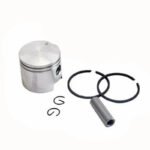
Farm equipment plays a vital role in ensuring the success of agricultural operations, landscaping projects, and even small DIY farming endeavors. Whether you’re a seasoned farmer, a professional landscaper, or a passionate DIY enthusiast, keeping your tools and machinery clean is essential. Regular cleaning not only improves performance but also extends the life of your equipment. This guide will walk you through the best practices for cleaning farm equipment, ensuring it’s ready for your next big task.
Why Cleaning Farm Equipment is Essential
Cleaning farm equipment isn’t just about aesthetics; it’s a crucial maintenance practice that ensures your tools and machines function at their best. Here are some reasons why it matters:
- Prevents Rust and Corrosion: Dirt, moisture, and chemicals can corrode metal parts over time, reducing the lifespan of your equipment.
- Improves Efficiency: Clean machinery operates more smoothly and efficiently, saving time and energy.
- Ensures Safety: Removing debris and buildup helps prevent malfunctions and accidents.
- Saves Money: Regular maintenance reduces the need for costly repairs or replacements.
- Preserves Traditional Farming Techniques: Clean tools honor the heritage of Sri Lankan agriculture and ensure the efficiency of traditional practices.
Tools and Supplies You Need for Cleaning
Before diving into the cleaning process, gather the right tools and supplies. Having the proper equipment ensures the job is thorough and efficient.
Essential Cleaning Tools
- Brushes: Use a combination of stiff and soft-bristled brushes for different surfaces.
- Scrapers: Ideal for removing hardened dirt or debris.
- Cloths and Towels: For wiping down surfaces and drying.
- Buckets: Essential for carrying water and cleaning solutions.
- Pressure Washer: For powerful cleaning of large equipment.
- Air Compressor: Helps blow out debris from hard-to-reach areas.
Cleaning Agents
- Mild detergent or soap.
- Degreasers for oily parts.
- Eco-friendly cleaning solutions that are safe for agricultural environments.
Protective Gear
- Gloves to protect your hands.
- Goggles to shield your eyes from splashes.
- Waterproof boots for comfort and safety.
Step-by-Step Guide to Cleaning Your Farm Equipment
1. Preparation
- Turn Off and Cool Down: Ensure all machinery is turned off and has cooled down before cleaning.
- Gather Tools: Set up your cleaning area with all the necessary supplies.
- Choose the Right Spot: Work in a well-ventilated area away from crops or sensitive plants.
2. Dry Cleaning
- Use Brushes and Scrapers: Start by removing dirt, mud, and debris using brushes and scrapers. Focus on areas where buildup is common, such as wheel treads, blades, and joints.
- Pay Attention to Details: Clean vents, grills, and small crevices where dirt can accumulate.
3. Washing
- Rinse with Water: Use a hose or pressure washer to rinse off loose dirt. Adjust the pressure to avoid damaging delicate parts.
- Apply Cleaning Solution: Mix a mild detergent or eco-friendly cleaning agent with water. Scrub the surface using brushes.
- Focus on Moving Parts: Clean belts, gears, and blades carefully to remove grease and debris.
- Rinse Thoroughly: Remove all soap residue with clean water.
4. Drying and Lubrication
- Dry Completely: Use towels or an air compressor to dry the equipment. Ensure no moisture remains to prevent rust.
- Lubricate Moving Parts: Apply oil or grease to hinges, gears, and other moving parts to keep them running smoothly.
5. Inspection
- Check for Damage: Look for signs of wear, cracks, or rust.
- Replace Worn Parts: Identify and replace any damaged components to avoid future issues.
Tips for Maintaining Clean Equipment
Regular cleaning is key to keeping your tools in top condition. Follow these tips to maintain clean farm equipment:
- Create a Cleaning Schedule: Clean frequently used equipment weekly or after every use.
- Seasonal Maintenance: Perform deep cleaning and maintenance before and after planting or harvesting seasons.
- Store Properly: Keep equipment in a dry, covered area to protect it from dust and moisture.
- Use Covers: Invest in protective covers to shield machines from dirt and weather.
- Check Manufacturer Guidelines: Follow the maintenance instructions provided by the manufacturer for specific cleaning recommendations.
Ancient Cleaning Techniques vs. Modern Practices
Sri Lankan agriculture has a rich history of traditional farming techniques, including the cleaning and maintenance of tools. Here’s how ancient methods compare to modern practices:
Traditional Techniques
- Using natural cleaning agents like ash or tamarind.
- Rinsing tools in streams or ponds.
- Drying equipment under the sun to prevent rust.
Modern Practices
- Advanced tools like pressure washers and air compressors.
- Chemical cleaning agents designed for heavy-duty use.
- Lubricants that improve the performance of moving parts.
Balancing traditional wisdom with modern technology ensures sustainable and effective equipment care.
Recommended Cleaning Products and Resources
Finding the right products for cleaning and maintaining farm equipment can be a game-changer. Here are some suggestions:
- Brushes and Scrapers: Durable tools for removing tough dirt.
- Eco-Friendly Cleaning Agents: Safe for the environment and effective on machinery.
- Lubricants: High-quality oils and greases for moving parts.
- Pressure Washers: Ideal for cleaning large equipment efficiently.
Explore these products and more at lakparts.com or check out other farming resources at vagaa.lk for reliable agricultural tools and tips.
Common Mistakes to Avoid When Cleaning Equipment
Even with the best intentions, some mistakes can harm your equipment. Here’s what to watch out for:
- Using Harsh Chemicals: Avoid strong acids or solvents that can damage paint and metal parts.
- Skipping Lubrication: Failing to lubricate moving parts can lead to wear and tear.
- Ignoring Manufacturer Instructions: Always follow specific cleaning guidelines provided by the equipment manufacturer.
- Rushing the Process: Take the time to clean thoroughly to avoid missing critical areas.
- Storing While Wet: Ensure the equipment is completely dry before storage to prevent rust.
Regularly cleaning your farm equipment is more than a chore; it’s a vital step in maintaining your investment. By following this step-by-step guide, you can ensure that your tools and machinery remain in excellent condition, ready to deliver top performance when you need them.
Don’t forget to check out cleaning supplies and accessories at lakparts.com for all your equipment maintenance needs. With the right tools, a little effort, and a commitment to care, you can make your farming and landscaping tasks smoother and more efficient.




